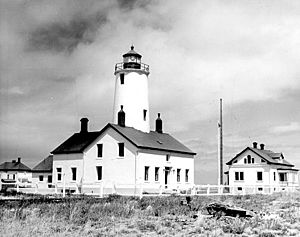New Dungeness Light facts for kids
 |
|
| Dungeness Lighthouse after 1927 | |
|
|
|
| Location | Sequim, Washington |
|---|---|
| Coordinates | 48°10′54″N 123°06′37″W / 48.18175°N 123.11029°W |
| Year first constructed | 1857 |
| Year first lit | 1857 |
| Automated | 1976 |
| Foundation | Surface |
| Construction | Brick, sandstone and stucco |
| Tower shape | Conical |
| Height | 63 feet (19 m) |
| Original lens | Third order Fresnel lens (removed) |
| Range | 18 nautical miles (33 km; 21 mi) |
| Characteristic | Alternating white flash every 5 seconds |
The New Dungeness Light is a helpful light that guides ships. It stands on the Dungeness Spit in the Dungeness National Wildlife Refuge. This area is close to Sequim in Washington state. The lighthouse has been working non-stop since 1857. Even though it's been active for so long, the tower is now 26 feet (7.9 m) shorter than when it was first built.
Contents
The Story of New Dungeness Light
The New Dungeness Light first shone in 1857. It was the second lighthouse built in the Washington territory. The first was the Cape Disappointment Light in 1856. When it was new, the lighthouse had a 1½-story building with a 100-foot (30 m) tower on its roof. The top half of the tower was black, and the bottom half was white.
Over time, the tower started to get cracks. These cracks were likely caused by earthquakes and bad weather. By 1927, the cracks were so serious that the chief lighthouse engineer, Clarence Sherman, worried the tower might fall. So, they decided to make the tower shorter. It was lowered to its current height of 63 feet (19 m).
With the shorter tower, the original Fresnel lens was too big. To save money, they took the top part of the old Admiralty Head lighthouse. This part, called the lantern room, was placed on top of the shorter New Dungeness tower. A new, smaller revolving Fresnel lens was then installed.
Changes to the Light Source
In the mid-1970s, the Coast Guard changed the light. They removed the Fresnel lens and tried out a bright airport-style beacon. This beacon only worked for a few years. It was then replaced by a smaller, more energy-efficient light. This new light used a 150-watt bulb instead of a 1,000-watt one. In 1998, the Coast Guard updated the light again. They installed a newer Vega rotating beacon.
A Historic Place
The New Dungeness Light Station is a special historic area. It covers about 8 acres (3.2 ha) of land. This area includes the lighthouse, the keeper's house, and three other important buildings. In 1993, this entire area was added to the National Register of Historic Places. This means it's recognized as an important historical site.
Lighthouse Keepers and Volunteers
Henry Blake was the very first keeper of the New Dungeness Lighthouse. A Coast Guard ship, the WLM-563 Henry Blake, is named after him. Franklin Tucker was a temporary keeper in 1857. He later returned in 1873 and stayed until 1882. After him, Amos Morgan took over until 1896. In the late 1890s, Oscar Brown and Joseph Dunn also served as keepers.
By 1994, the Dungeness Lighthouse was one of the few lighthouses in the U.S. that still had full-time keepers. Michelle and Seth Jackson, along with their dog Chicago, were the last official keepers. In March 1994, the Coast Guard closed up the station.
However, a group called the New Dungeness Light Station Association stepped in. Since September 1994, members of this group have volunteered to keep the station running. They make sure someone is at the lighthouse 24 hours a day, every day of the year. Visitors can also take tours of the lighthouse daily between 9 AM and 5 PM.


